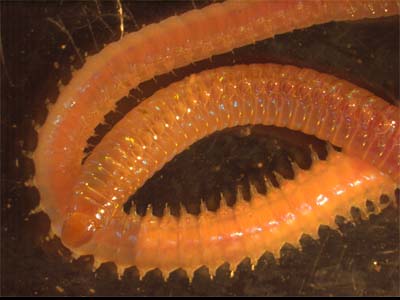Polychaeta: Bristle Worms

Polychaete worms form a major component of the soft sediments in the world oceans and also in the Arctic . With over 8,000 species worldwide, and an estimated 470 species in the Arctic, their diversity of lifestyles, body shapes and colors is impressive, although little appreciated by the casual observer. Together with a group of crustaceans and bivalves, bristle worms form the core organisms within the so-called macrofauna.
Most bristle worms are less than 10 cm long and 0.2-1 cm wide and often live buried in the sediment, either crawling between sediment grains of living in secreted stationary tubes. Some tubes resemble complex artwork such as the perfectly symmetrical 'ice-cream cone' of Pectinaria or tubes composed of small bivalve shells. Many polychaetes are deposit feeders while others are predators.
The body of most bristle worms is partitioned into identical cylindrical segments. Each segment bears a pair of small paddle-like appendages, the so-called parapodia, and a complete set of most body organs such as nephridia (kidney-like organs), a set of blood vessels and ganglia (nerve cell clusters). Many polychaetes can regrow a major part of their body when parts get eaten by a predator.
Page Author: Bodil Bluhm
Created: Oct 24, 2008



